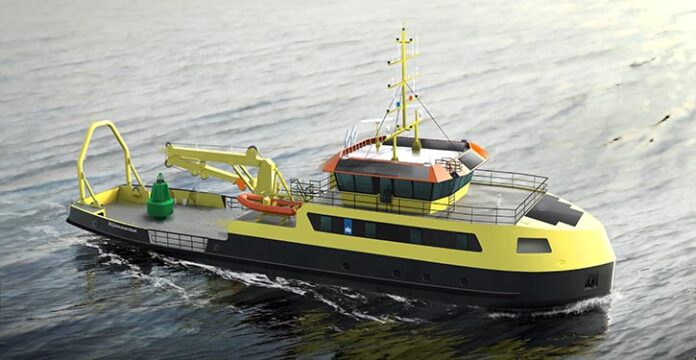EST-Floattech, a young company with offices in the Netherlands and Scandinavia, supplies the Green Orca 1050 accumulators used in the vessels, which provide more than 2.5 MWh in total of Lithium-Ion Polymer NMC Energy Storage.
Rijkswaterstaat focuses on sustainability
This is the first time that Rijkswaterstaat has commissioned such multi-functional and energy-efficient vessels. The MPV 30s are each equipped with EST-Floattech’s Green Orca 1050 accus, which provide 882 kWh of electricity, allowing the vessel to conduct all of their day-to-day activities under electric power. The vessels’ accus supply enough electricity to run the vessel and all of the equipment on board, including the deck hoists, lights, etc., without consuming a drop of fuel.
The Multi-Purpose Vessel (MPV 30) combines a variety of functions, such as channel marking, patrolling, survey and fishery monitoring, all on a single vessel. Rijkswaterstaat will use the MPV 30 on the Netherlands’ major inland waterways, the Wadden Sea, and up to 30 miles off the Netherlands’ North Sea coast. With the construction of these vessels, Rijkswaterstaat has taken a major step forward in making the fleet more sustainable.
Innovative ship design by Bijlsma Wartena
Bijlsma Wartena designed the hydrodynamics of the hull to reduce the water resistance, which means the vessel uses even less energy for propulsion. The MPV 30 is unique in that it can sail in two directions by turning the propulsion under the vessel, allowing it to keep working in even the roughest seas.
The heat generated by the engines is re-used by the vessel’s radiators, boilers and deck heaters. The new vessels are highly energy-efficient, and the on-board solar panels provide extra energy for the crew accommodations (the ‘hotel load’).
Bijlsma Wartena Managing Director Tjeerd Wiebe Bijlsma said:
“The MPV 30 is the first working ship in the Netherlands that is capable of fully electric operation. It is unprecedented for such a large seagoing vessel to be able to function entirely without diesel power. These types of ships and applications represent a great opportunity for the Dutch shipbuilding industry.”
“Sustainability is an absolutely vital aspect for every maritime organisation. It’s great to see how closely the parties involved (Piet Brouwer, Bijlsma Wartena and EST-Floattech) worked so closely together, and how we functioned as a team by speaking the same language and by offering Rijkswaterstaat such an innovative and sustainable solution.”
Hybrid benefits
With its hybrid power system, the ship can sail under full electric power or use its engines to sail as efficiently as possible by generating electricity with a precise coordination between the accumulators and the motors. The engines run at the optimal RPMs in order to minimise emissions of fine particulates, CO2 and NOx, and to significantly reduce fuel consumption. The optimal engine load, combined with the reduced soot emissions, also mean that the vessel is much less expensive to maintain.
Facts and Figures
The first two boats will be delivered in 2018, and the third will follow in 2019.
- The MPV 30 is 40 meters long (LOA).
- Installed diesel power: 2 CAT C18 (2x 550 KW)
- Green Orca 1050 accus provide a total of 2.646 KWh for all 3 vessels.




